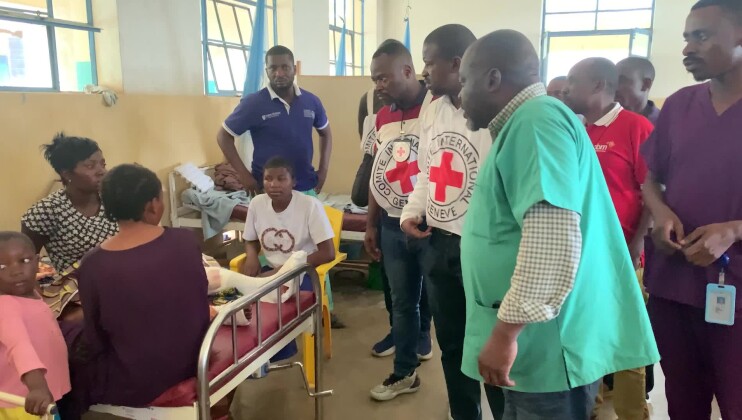20 Years after Ottawa: Landmines still Destroy Lives
It is 20 years since the Ottawa Convention banning anti-personnel landmines was adopted, but the legacy of these devastating weapons lives on. Landmines need just an instant to create a catastrophic injury that lasts a lifetime. And for decades, landmines were used in huge numbers, all over the world. In the years before the Convention, Erik Tollefsen, the ICRC’s head of Weapons Contamination, remembers mine clearance as an almost hopeless task.
“When I first got involved with landmine clearance and clearance of explosive remnants of war back in the early 90s in Lebanon and Bosnia during the Balkan wars, it was like the work of Sisyphus,” he explains.
“Even though we were working as hard as possible to remove landmines and other weapons, more mines were put into the ground, we saw the statistics of victims rising from year to year.”
162 states have ratified the convention, and nearly all countries have stopped using landmines, but there are millions of mines, deployed decades ago, still in the ground. In Zimbabwe, ICRC supported teams are clearing mines laid in the early 1970’s. Their presence, says Erik Tollefsen, threatens entire communities, not just with terrible injury, but with poverty: vast areas of farm land cannot be used.
“Today landmines and other unexploded ordinance such as cluster munitions are presenting a huge menace in post conflict scenarios,” he says.
“It’s not just a hindrance to human security, but it is also preventing life to go back to normality.”
Landmines cause profound injuries: losing a limb can mean a child can no longer get to school, can no longer play. For adults, the opportunity to work and earn a living can be wiped out.
In 1997, an estimated 20,000 people, the majority of them civilians, were killed or maimed by landmines every year. After the Ottawa Convention, the numbers gradually decreased, down to around 6500 a year. But that is still 6500 too many, and in recent years there has even been a worrying increase. The reason, says Erik Tollefsen, is the changing nature of conflict.
The big problem today is non state actors,” Erik explains.
“Many of these conflicts that we see on the news and in the newspapers every day that are high up there, we see that more, much more improvised landmines, homemade artisanal mines are being used than we are able to clear.”
In Afghanistan, the ICRC has been running a physical rehabilitation centre since 1988. Patients, many of them landmine victims, are fitted with prosthetic limbs, and then supported to learn to use them, and regain their mobility.
It is a huge achievement, but to really fulfill the goals of the Ottawa Convention, more is needed, and Erik Tollefsen worries that countries may have become complacent.
“In the past 20 years since the advent of the anti personnel mine ban convention, a lot of work has been done,” he says.
“Many hundreds of thousands of square kilometers have been cleared, and millions of mines have been destroyed.”
“Despite that fact the battle has not yet been won. We need to stay on the course, we need to do more, we need to continue the funding, we have seen funding dropping over the past few years and this is highly disturbing.”
It is a fantastic moment when landmine victims can get on their feet again. But the path to that moment is long, painful, often frightening, and costly to individuals, families, and entire countries. 20 years on from Ottawa, much work remains to be done: because the final goal must be no landmines, and no landmine victims.
Download this footage from ICRC Video Newsroom
www.icrcvideonewsroom.org
For further information, please contact:
Ayuna Batoeva, ICRC Geneva, +41 79 642 75 94, abatoeva@icrc.org
Juliette Ebele, ICRC Geneva, + 41 79 949 35 12, jebele@icrc.org
Follow the ICRC on facebook.com/icrc and twitter.com/icrc
SHOTLIST
Location: Various (Yemen, Zimbabwe, Iraq, Afghanistan, Geneva)
0:00 – 0:20 Various landmine victims waiting at clinic
0:20 – 0:55 Soundbite, Erik Tollefsen, ICRC Head of Weapons Contamination (English original) “When I first got involved with landmine clearance and clearance of explosive remnants of war back in the early 90s in Lebanon and Bosnia during the Balkan wars, it was like the work of Sisyphus. Even though we were working as hard as possible to remove landmines and other weapons, more mines were put into the ground, we saw the statistics of victims rising from year to year.”
0:55 – 1:34 Various landmine clearance Zimbabwe
1:34 – 2:01 Soundbite, Erik Tollefsen, ICRC Head of Weapons Contamination (English original) “Today landmines and other unexploded ordinance such as cluster munitions are presenting a huge menace in post conflict scenarios. It’s not just a hindrance to human security, but it is also preventing life to go back to normality.”
2:01 – 2:42 Various landmine victims practising with prosthetic limbs
2:42 – 3:07 Soundbite, Erik Tollefsen, ICRC Head of Weapons Contamination (English original) “The big problem today is non state actors. Many of these conflicts that we see on the news and in the newspapers every day that are high up there, we see that more, much more improvised landmines, homemade artisanal mines are being used than we are able to clear.”
3:07 – 3:17 Exteriors ICRC Orhopaedic Centre Kabul
3:17 – 3:32 Interiors centre, patients being fitted with prosthetic limbs
3:32 – 4:10 Soundbite, Erik Tollefsen, ICRC Head of Weapons Contamination (English original) In the past 20 years since the advent of the anti personnel mine ban convention, a lot of work has been done. Many hundreds of thousands of square kilometers have been cleared, and millions of mines have been destroyed. Despite that fact the battle has not yet been won. We need to stay on the course, we need to do more, we need to continue the funding, we have seen funding dropping over the past few years and this is highly disturbing.”
4:10 – 4:49 various, patients with prosthetic limbs playing football
Length: 4:49
Format: HD H264 mov
Producers: Various
Camera: Various
ICRC ref: AV739N
Date: 30.11.2017
Copyright: ICRC access all



